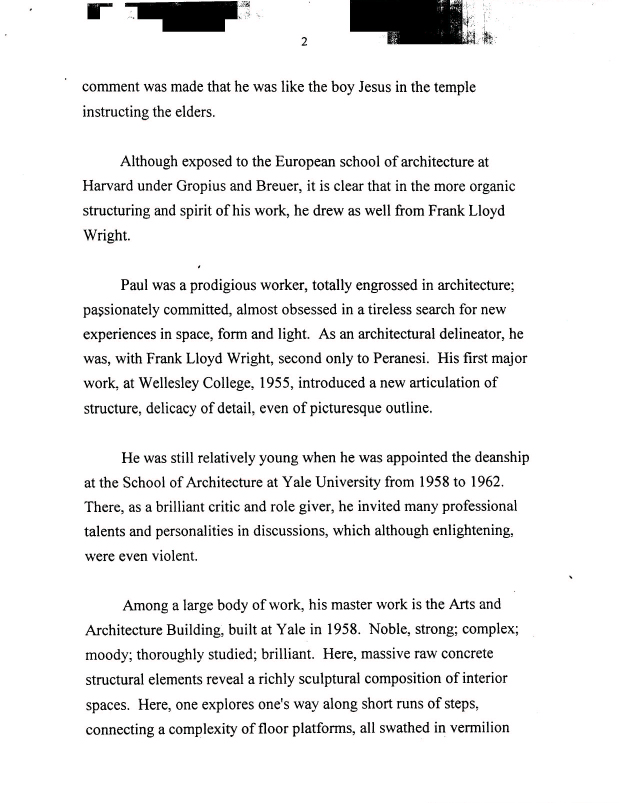A Tribute to Paul Rudolph - April 07, 1998
INTRODUCTION
The below text was written by John M. Johansen and delivered to the Academy of Arts and Letters.
[Note: in transcribing this text, we have retained most of the grammar, spelling, capitalization, and construction.]
======================================
A Tribute to Paul Rudolph
By John M. Johansen
The last time I was asked to read a tribute to an Academy member who has passed from our company was a tribute to Jose Sert. I referred to him, at that time, as the "last of the first generation of modern architects, among them Frank Lloyd Wright, Mies, Gropius, Le Corbusier." They were the "giants" whose strides were too lengthy for us to reach.
Now we give tribute to a member of the second generation, Paul Rudolph, whom I have known and respected for some fifty years. The work of this generation, surviving at the Academy - Pei, Johnson, Roche, Barnes and myself - followed those modern principles we inherited from the "Giants", but with others, led a transitional phase in the Modern Movement in America, characterized by transformations of explosive diversity, originality and enrichment of expression.
In this transformation, Paul took an early lead. He designed buildings that were of a new spirit. While as an impatient and impudent young man, he assailed the United Nations Buildings as pompous and tedious. At a national AIA convention, he urged established architects to breathe more life into their buildings; more richness of form and space, more animation. At that occasion, one comment was made that he was like the boy Jesus in the temple instructing the elders.
Although exposed to the European school of architecture at Harvard under Gropius and Breuer, it is clear that in the more organic structuring and spirit of his work, he drew as well from Frank Lloyd Wright.
Paul was a prodigious worker, totally engrossed in architecture; passionately committed, almost obsessed in a tireless search for new experiences in space, form and light. As an architectural delineator, he was, with Frank Lloyd Wright, second only to Piranesi. His first major work, at Wellesley College, 1955, introduced a new articulation of structure, delicacy of detail, even of picturesque outline.
He was still relatively young when he was appointed the deanship at the School of Architecture at Yale University from 1958 to 1962. There, as a brilliant critic and role giver, he invited many professional talents and personalities in discussions, which although enlightening, were even violent.
Among a large body of work, his master work is the Arts and Architecture Building, built at Yale in 1958. Noble, strong; complex; moody; thoroughly studied; brilliant. Here, massive raw concrete structural elements reveal a richly sculptural composition of interior spaces. Here, one explores one's way along short runs of steps, connecting a complexity of floor platforms, all swathed in vermilion carpet. While unexpected and mysterious, hidden sources of natural light lead the way.
In his creative process, Paul had “pre-lived”, as it were, the experiences of these spaces every step of the way. It could only be that, earlier, at his drawing board, he had in his imagination, projected himself into a reality that was not there yet.
Paul's spirits were broken when this fine building was damaged by fire in the 60's, it is said by radical college students. I was told that he never revisited the building again. However, renovated, it stands again as his finest work. His spirit was more challenged in the 80's, during the latter years of his professional life. For many of the third generation of architects which followed us, they were not Modernist, but Post-Modernist. The promotion and hype which popularized buildings, drawn from the images of Disneyland, Las Vegas and stylistic sources, left him somewhat out of the picture. As critic Kenneth Frampton said of Rudolph and other Modernists, “he has been for two decades, systematically ignored.”
Undaunted by the resultant loss of his commissions in the USA, Paul, at 75 years of age, directed his talents to the Far East and Asia. There his greatest high-rise buildings now stand, in Singapore, Hong Kong and Indonesia.
We celebrate the fullness of his life and the fullness he has exhorted in the lives of others. The energy, creative power and joy we felt in his personality still emanates from his buildings. Teacher, author, critic and most gifted design, it is inconceivable that the continuum of the Modem Movement in Architecture could have progressed, and this day, prevailed, without him.
======================================




